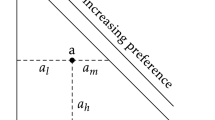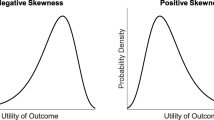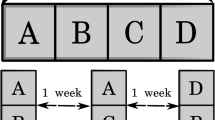Abstract
Data from a risky choice experiment are used to estimate a fully parametric stochastic model of risky choice. As is usual with such analyses, Expected Utility Theory is rejected in favour of a form of Rank Dependent Theory. Then an estimate of the risk aversion parameter is deduced for each subject, and this is used to construct a measure of the “closeness to indifference'' of each subject in each choice problem. This measure is then used as an explanatory variable in a random effects model of decision time, with other explanatory variables being the complexity of the problem, the financial incentives, and the amount of experience accumulated at the time of performing the task. The most interesting finding is that significantly more effort is allocated to problems in which subjects are close to indifference. This presents us with another reason (in addition to statistical information considerations) why such tasks should play a prominent role in experiments.
Similar content being viewed by others
References
Bacharach, M. (2001). “Choice Without Preference: A Study of Decision Making in Buridan Problems.” mimeo, University of Oxford.
Buschena, D. and Zilberman, D. (2000). “Generalized Expected Utility, Heteroscedastic Error, and Path Dependence in Risky Choice.” Journal of Riskand Uncertainty. 20, 67–88.
Camerer, C.F. and Hogarth, R.M. (1999). “The Effects of Financial Incentives in Experiments: A Review and Capital-labor-production Framework.” Journal of Risk and Uncertainty. 19, 7–42.
Cleveland, W.S. (1979). “Robust Locally Weighted Regression and Smoothing Scatterplots.” Journal of the American Statistical Association. 74, 829–836.
Hey, J.D. (1995). “Experimental Investigations of Errors in Decision Making Under Risk.” European Economic Review. 39, 633–640.
Hey, J.D.(2001). “Does Repetition Improve Consistency.” Experimental Economics. 4, 5–54.
Hey, J.D. and Orme, C. (1994). “Investigating Generalisations of Expected Utility Theory Using Experimental Data.” Econometrica. 62, 1291–1326.
Huber, J. and Zwerina, K. (1996). “The Importance of Utility Balance in Efficient Choice Designs.” Journal of Marketing Research. 23, 307–17.
Little, I.M.D. (1949). “A Reformulation of the Theory of Consumer's Behaviour.” Oxford Economic Papers. 1, 90–99.
Loomes, G., Moffatt, P.G. and Sugden, R. (2002). “A Microeconometric Testof Aalternative Stochastic Theories of Risky Choice.” Journal of Risk and Uncertainty. 24, 103–130.
Loomes, G. and Sugden, R. (1998). “Testing Different StochasticSpecifications of Risky Choice.” Economica. 65, 581–598.
Moffatt, P.G. and Peters S.A. (2001). “Testing for the Presence of a Tremble in Economic Experiments.” Experimental Economics. 4, 221–228.
Prelec, D. (1998). “The Probability Weighting Function.” Econometrica. 66, 497–527.
Tversky, A. and Fox, C.R. (1994). “Weighting Risk and Uncertainty.” Psychological Review. 102, 269– 283.
Wilcox, N.T. (1994). “On A Lottery Pricing Anomaly: Time Tells the Tale.” Journal of Risk and Uncertainty, 8, 311–324.
Wu, G. and Gonzalez, R. (1996). “Curvature of the Probability Weighting Function.” Management Science, 42, 1676–1690.
Author information
Authors and Affiliations
Corresponding author
Additional information
JEL Classification: C23, C91, D81
Rights and permissions
About this article
Cite this article
Moffatt, P.G. Stochastic Choice and the Allocation of Cognitive Effort. Exp Econ 8, 369–388 (2005). https://doi.org/10.1007/s10683-005-5375-6
Received:
Revised:
Accepted:
Issue Date:
DOI: https://doi.org/10.1007/s10683-005-5375-6




